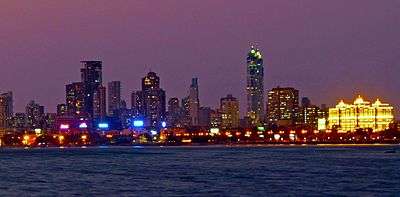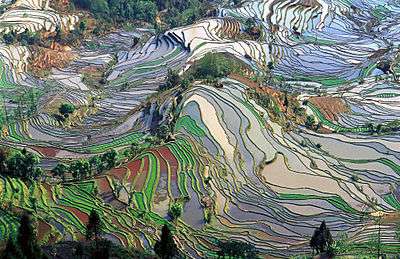Economy of Asia
| Statistics | |
|---|---|
| Population | 4.2 billion (60% of the world) |
| GDP |
Nominal: US$18.515 trillion (2010) PPP: US$24.077 trillion (2010) |
GDP growth | Per capita: 7.9% (2010)[1] |
GDP per capita |
Nominal: US$4,629 (2009) PPP: US$7,041 (2009) |
| 3.37 million (2011)[2] | |
| Unemployment | 3.8% (2010 est.) |
|
Most numbers are from the International Monetary Fund. All values, unless otherwise stated, are in US dollars. | |
| World economy |
|---|
The Economy of Asia comprises more than 4.4 billion people (60% of the world population) living in 49 different states.[3] Six further states lie partly in Asia, but are considered to belong to another region economically and politically. Asia is the fastest growing economic region and the largest continental economy by GDP PPP in the world. China and India are currently the first and third largest economies in the world, respectively. Moreover, Asia is the site of some of the world's longest modern economic booms, starting from the Japanese economic miracle (1950–1990), Miracle of the Han River (1961–1996) in South Korea and the economic boom (1978–2013) in China.
As in all world regions, the wealth of Asia differs widely between, and within, states. This is due to its vast size, meaning a huge range of different cultures, environments, historical ties and government systems. The largest economies in Asia in terms of PPP gross domestic product (GDP) are China, India, Japan, Russia, South Korea, Indonesia, Turkey, Iran, Saudi Arabia, Taiwan, Thailand, Pakistan, Malaysia and Philippines and in terms of nominal gross domestic product (GDP) are China, Japan, India, Russia, South Korea, Indonesia, Turkey, Philippines, Saudi Arabia, Taiwan, United Arab Emirates, Thailand, Iran, Malaysia and Singapore .
Wealth (if measured by GDP per capita) is mostly concentrated in the East Asian territories of Brunei, Hong Kong, Japan, Macau, Singapore, South Korea and Taiwan, as well as in oil rich countries in West Asia such as Saudi Arabia, Qatar, United Arab Emirates, Bahrain, Iran, Kuwait, and Oman. Israel and, to a lesser extent Turkey are exceptions: both lie in the territory of Asia despite not often being counted as such. Israel (entrepreneurship on diversified industries) is a developed country, while Turkey (founding member of OECD) is an advanced emerging country. Asia, with the exception of Japan (heavy industry and electrical sophistication), South Korea (heavy industry and information and communication technology), Taiwan (light industry and hi-tech parts manufacturing), Hong Kong (financial industry and services) and Singapore (high-tech manufacturing, rig building, biotechnology, financial and business services), is currently undergoing rapid growth and industrialization spearheaded by China (manufacturing and FDI-led growth [4]) and India (commodities, outsourcing destination and computer software), the two fastest growing major economies in the world. East Asian and Southeast Asian countries generally rely on manufacturing and trade (and to industry and commerce [5]), and incrementally building on high-tech industry and financial industry[6] for growth, countries in the Middle East depend more on the production of commodities, principally Sweet crude oil,[7] for economic growth. Over the years, with rapid economic growth and large trade surplus with the rest of the world, Asia has accumulated over US$4 trillion of foreign exchange reserves – more than half of the world's total, for Tertiary sector of the economy and Quaternary sector of the economy to expand in the share of Asia's economy.

.jpg)

Economic development
Ancient and medieval times
China and India alternated in being the largest economies in the world from 1 to 1800 A.D. China was a major economic power and attracted many to the east,[8][9][10][11] and for many the legendary wealth and prosperity of the ancient culture of India personified Asia,[12] attracting European commerce, exploration and colonialism. The accidental discovery of America by Columbus in search for India demonstrates this deep fascination. The Silk Road became the main East-West trading route in the Asian hitherland while the Straits of Malacca stood as a major sea route.
Pre–1945
Prior to World War II, most of Asia was under colonial rule. Only relatively few states managed to remain independent in the face of constant pressure exerted by European power. Such examples are China, Siam and Japan.[13]
Japan in particular managed to develop its economy due to a reformation in the 19th century. The reformation was comprehensive and is today known as the Meiji Restoration.[14] The Japanese economy continued to grow well into the 20th century and its economic growth created various shortages of resources essential to economic growth. As a result, the Japanese expansion began with a great part of Korea and China annexed, thus allowing the Japanese to secure strategic resources.[15]
At the same time, Southeast Asia was prospering due to trade and the introduction of various new technologies of that time. The volume of trade continued to increase with the opening of the Suez Canal in the 1860s. Manila had its Manila galleon wherein products from the Philippines were traded to Europe.[16] The Philippines was the first Asian country to trade with Latin America via Acapulco. Tobacco, coconut, corn, and sugar trade was the most in demand during that time. Singapore, founded in 1819, rose to prominence as trade between the east and the west increased at an incredible rate. The British colony of Malaya, now part of Malaysia, was the world's largest producer of tin and rubber. The Dutch East Indies, now Indonesia, on the other hand, was known for its spices production. Both the British and the Dutch created their own trading companies to manage their trade flow in Asia. The British created the British East India Company while the Dutch formed Dutch East India Company. Both companies maintained trade monopolies of their respective colonies.[17][18][19]
In 1908, crude oil was first discovered in Persia, modern day Iran. Afterwards, many oil fields were discovered and it was learnt later that the Middle East possesses the world's largest oil stocks. This made the rulers of the Arab nations very rich though the socioeconomic development in that region lagged behind.[20]
In the early 1930s, the world underwent a global economic depression, today known as the Great Depression. Asia was not spared, and suffered the same pain as Europe and the United States. The volume of trade decreased dramatically all around Asia and indeed the world. With falling demand, prices of various goods starting to fall and further impoverished locals and foreigners alike. In 1931 Japan invaded Manchuria bringing World War Two to Asia. On December 7, 1941 Japan launched a surprise attack on the US military base at Pearl Harbor causing the US to declare war.[21]
1945–1990
Following World War II, the People's Republic of China and India, which account for half of the population of Asia, adopted socialist policies to promote their domestic economy. These policies limited the economic growth of the region. They are being abandoned in India and reformed in China. In contrast, the economies of Japan and the Four Asian Tigers (South Korea, Taiwan, Singapore and Hong Kong) were economic successes, and the only successful economies outside of the Western World.[22] The success of these four economies led other Southeast Asian countries, namely Indonesia, Malaysia and Thailand to follow suit in opening up their economies and setting up export-oriented manufacturing bases that boosted their growth throughout the 1980s and the 1990s.[23]
One of the most pronounced Asian economic phenomenons during this time, the Japanese post-war economic miracle, greatly impacted the rest of the world. After World War II, under central guidance from the Japanese government, the entire economy was undergoing a remarkable restructuring. Close cooperation between the government, corporations and banks facilitated easy access to much-needed capital, and large conglomerates known as keiretsu spurred horizontal and vertical integration across all industries, keeping out foreign competition. These policies, in addition to an abandonment of military spending, worked phenomenally well. Japanese corporations as a result exported and still export massive amounts of high quality products from "the Land of the Rising Sun".[24]
Another amazing economic success story is that of South Korea's, also referred to as the Miracle on the Han River. The country was left impoverished after the Korean War, and until the early 1970s was among the world's poorest countries (even poorer than North Korea). However, it was since able to recover with double digit annual growth rates. Many conglomerates, also known as chaebols, such as Samsung, LG Corp, Hyundai, Kia, SK Group, and more grew tremendously during this period. South Korea has now become the most wired country in the world.[25]
Taiwan and Hong Kong experienced rapid growth up till the 1990s. Taiwan became, and still remains one of the main centers of consumer electronics R&D as well as manufacturing. However, unlike in Japan and South Korea, the bulk of Taiwan's economy is dependent on small to medium-sized businesses. Hong Kong, on the other hand, experienced rapid growth in the financial sector due to liberal market policies, with many financial institutions setting up their Asian headquarters in Hong Kong. Till today, Hong Kong has been ranked as the world's freest economy for many years running, and it remains among one of the world's top 5 leading financial centers.[26]
In Southeast Asia, economic development was fueled by the growth of the bamboo network. The bamboo network refers to a network of overseas Chinese businesses operating in the markets of Southeast Asia that share common family and cultural ties.[27] The network expanded as Chinese refugees emigrated to Southeast Asia following the Chinese Communist Revolution in 1949.[28] Singapore in particular experienced very rapid economic growth after declaring independence in 1965, following a two-year federation with Malaysia. In addition to creating a conducive economic and political climate, the government developed the skills of its multi-racial workforce, and established export-oriented industries by encouraging foreign investors to set up regional operations in manufacturing. The government also played a prominent role in Singapore's growth as a major financial and business services centre. Singapore is today one of the richest countries in the world, both in terms of GNI per capita, and GDP (PPP) per capita.
This period was also marked by military conflict. Wars driven by the Cold War, notably in Vietnam and Afghanistan, wrecked the economies of these respective nations. When the Soviet Union collapsed in 1990-91, many Central Asian states were cut free and were forced to adapt to pressure for democratic and economic change. Also, several of the USSR's allies lost valuable aid and funding.[29]
1991–2007
The Chinese economy boomed under the economic measures undertaken by Deng Xiaoping, in the late 1970s, and continuing under Jiang Zemin in the 1990s. After the liberalization of the economy of India, growth in India and China increasingly shifted the center of gravity of the global economy towards Asia. In 2007, China's economic growth rate exceeded 11% while India's growth rate increased to around 9%. One of the factors was the sheer size of the population in this region. Surprisingly, this size of population was considered as biggest reason for lack of growth of economy by both governments earlier and both countries have taken strong population control measures to improve their economy.[30]
Meanwhile, South Korea, Taiwan, Hong Kong and Singapore emerged as the Four Asian Tigers with their GDPs growing well above 7% per year in the 1980s and the 1990s. Their economies were mainly driven by growing exports.[31] The Philippines only began to open up its stagnated economy in the early 1990s.[32] Vietnam's economy began to grow in 1995, shortly after the United States and Vietnam restored economic and political ties.[33]
Throughout the 1990s, the manufacturing ability and cheap labor markets in Asian developing nations allowed companies to establish themselves in many of the industries previously dominated by companies from developed nations. Asia became one of the largest sources of automobiles, machinery, audio equipment and other electronics.[34]
At the end of 1997, Thailand was hit by currency speculators, and the value of the Baht along with its annual growth rate fell dramatically. Soon after, the crisis spread to Indonesia, Malaysia, South Korea, Hong Kong, Singapore and many other Asian economies, resulting in great economic damage on the affected countries (Japan largely escaped the crisis). In fact, some of the economies, most notably those of Thailand, Indonesia, and South Korea actually contracted. This later would be known as the Asian financial crisis. By 1999, most countries had already recovered from the crisis.[35]
In 2001, almost all of the Asian and global Economies was affected by September 11 attacks, with Indonesia and Japan was hardest. But, In 2002/2003, Asian and global economies began to recover from the attacks in United States.[36]
In 2004, parts of Sumatra and South Asia were severely damaged by an earthquake and the subsequent tsunami. The tsunami wreaked havoc, causing massive damage in the infrastructure of the hit areas, particularly Indonesia, and displaced millions. For a short time, GDP contracted among nations such as Indonesia and Sri Lanka, despite massive inflow of foreign aid in the aftermath of the disaster.[37]
Japan suffered its worst post-World War II economic stagnation set in the early 1990s (which coincided with the end of Cold War), which was triggered by the latter event of Asian financial crisis in 1997. It, however, rebounded strongly in the early 2000s due to strong growth in exports, although unable to counteract China in 2005 after China gradually surpassed it as the largest economy in Asia.[38]
2008–present
In 2008, the Global Financial Crisis, triggered by the housing bubble in the United States, caused a significant decline in the GDP of the majority of the European economies. In contrast, most Asian economies experienced a temporary slowdown in their rates of economic growth, particularly Japan, South Korea, and China, resuming their normal growth soon after.[39]
The Arab Spring since 2011 had caused economic malaise in Syria, Lebanon and Yemen, amongst the most adversely affected nations in the Middle East. At the same time, in the early 2010s, Iraq, Saudi Arabia, the United Arab Emirates and Kuwait registered high GDP growths in the years that followed due to increased oil prices and further diversification of exports, as well as rising Foreign exchange reserves.[40]
In 2013, in a once-in-a-decade party leadership reshuffle in China (change of Hu-Wen Administration to Xi-Li Administration), the Chinese economy experienced a significant slowdown in the GDP growth, slowing down from the unprecedented decades of 9-10% annual growth to around 7-8%, which has significant effect in some developing economies, particularly in Southeast Asia and India, excluding the Philippines, which managed to grow at rates at par with China in the period 2012-2013. Philippines has been recently affected by the Typhoon Haiyan, the strongest storm on record, in November 2013, killing at least 5,200 and displacing millions more, although the disaster has a minimal effect on the country's economy by the dawn of 2014.[41]
On September 29, 2013, China opened the Shanghai Free-Trade Zone. This free trade zone allows international trade to be conducted with fewer restrictions and lower customs duties. The zone is tax free for the first ten years to encourage foreign direct investment (FDI) with a 'negative list' used to regulate in which fields foreign investments are prohibited.[42] The free trade zone allows for free exchange of the heavily regulated Chinese currency the yuan. Additionally, the zone provides financial support that benefits overseas investments for both individuals and business entities and opens the door for overseas financing which allows Chinese businesses to obtain foreign loans at lower interest rates.[43]
Future
Asia's large economic disparities are a source of major continuing tension in the region.[44] While global economic powers China, Japan, India, and South Korea continue powering through, and Indonesia, Malaysia, Philippines, Thailand, Vietnam, Bangladesh and Sri Lanka have entered the path to long-term growth, regions right next to these countries are in severe need of assistance.
Given the enormous quantity of cheap labor in the region, particularly in China and India, where large workforces provide an economic advantage over other countries, the rising standard of living will eventually lead to a slow-down. Asia is also riddled with political problems that threaten not just the economies, but the general stability of the region and world. The nuclear neighbors—Pakistan and India—constantly pose a threat to each other, causing their governments to invest heavily in military spending.[45]
Military intervention by the United States in Iraq and Afghanistan has also inflamed extremism and resulted in several terrorist attacks in a number of Asian countries. Another impending crisis is the depletion of oil reserves in the Middle East. Most of these economies have traditionally been over-dependent on oil and have had difficulty establishing another pillar in their economies.[46]
Yet another potential global danger posed by the economy of Asia is the growing accumulation of foreign exchange reserves. The countries/regions with the largest foreign reserves are mostly in Asia - China (Mainland - $2,454 billion & Hong Kong - $245 billion, June 2010), Japan ($1,019 billion, June 2009), Russia ($456 billion, April 2010), India ($345 billion, April 2015), Taiwan ($372 billion, September 2010), South Korea ($286 billion, July 2010), and Singapore ($206 billion, July 2010). This increasingly means that the interchangeability of the Euro, USD, and GBP are heavily influenced by Asian central banks. Some economists in the western countries see this as a bad thing, prompting their respective governments to take action.[47]
According to the World Bank, China may become the largest economy in the world sometime between 2020 and 2030, while India may become the second largest economy in the world sometime between 2030 and 2035.[48]
Based on Hurun Report, for the first time in 2012 Asia surpassed North America in amount of billionaires. More than 40 percent or 608 billionaires came from Asia, where as North America had 440 billionaires and Europe with 324 billionaires.[49]
Regional variation
Asian countries by GDP
This is a list of Asian countries sorted by their 2016 gross domestic product at market or government official exchange rates (nominal GDP) and PPP map is for year 2016.
2016 Nominal GDP and PPP list by the International Monetary Fund[50] (sortable; in billions of $US)
| Country or territory |
GDP nominal billions of USD |
GDP (PPP) billions of USD |
GDP (PPP) per capita USD |
Location |
|---|---|---|---|---|
| |
20.444 | 64.198 | 1,944 | South Asia |
| |
11.644 | 26.053 | 8,164 | West Asia |
| |
74.145 | 165.988 | 17,761 | West Asia |
| |
33.862 | 66.851 | 49,020 | West Asia |
| |
226.257 | 620.376 | 3,391 | South Asia |
| |
1.983 | 5.871 | 7,662 | South Asia |
| |
17.104 | 32.866 | 79,890 | Southeast Asia |
| |
68.277 | 244.365 | 4,752 | Southeast Asia |
| |
16.551 | 50.161 | 3,276 | Southeast Asia |
| |
11,383.033 | 20,853.331 | 13,224 | East Asia |
| |
23.263 | 27.516 | 30,882 | West Asia |
| |
4.970 | 6.745 | 5,479 | Southeast Asia |
| |
16.536 | 34.345 | 9,209 | West Asia |
| |
322.429 | 427.632 | 55,097 | East Asia |
| |
2,288.715 | 8,642.758 | 5,808 | South Asia |
| |
936.955 | 3,010.746 | 10,651 | Southeast Asia |
| |
386.120 | 1,439.295 | 17,443 | West Asia |
| |
148.411 | 588.737 | 15,348 | West Asia |
| |
311.739 | 292.809 | 33,136 | West Asia |
| |
4,412.603 | 4,901.102 | 37,519 | East Asia |
| |
35.878 | 79.907 | 11,971 | West Asia |
| |
128.109 | 433.909 | 24,108 | Central Asia |
| |
28.000 | 40.000 | 1,900 | East Asia |
| |
1,321.196 | 1,916.439 | 35,379 | East Asia |
| |
110.455 | 298.198 | 70,686 | West Asia |
| |
7.402 | 19.229 | 3,262 | Central Asia |
| |
11.681 | 34.532 | 5,006 | Southeast Asia |
| |
50.028 | 81.419 | 18,052 | West Asia |
| |
22.100 | 18.470 | 59,451 | East Asia |
| |
309.262 | 859.881 | 25,145 | Southeast Asia |
| |
2.885 | 4.554 | 13,312 | South Asia |
| |
12.037 | 34.869 | 11,919 | East Asia |
| |
19.761 | 67.137 | 2,388 | South Asia |
| |
77.779 | 176.211 | 43,847 | West Asia |
| |
270.961 | 982.380 | 4,749 | South Asia |
| |
16.809 | 18.595 | 2,470 | Southeast Asia |
| |
310.312 | 793.193 | 6,974 | Southeast Asia |
| |
170.860 | 333.936 | 137,162 | West Asia |
| |
1,132.739 | 3,684.643 | 24,449 | North Asia |
| |
618.274 | 1,720.027 | 52,311 | West Asia |
| |
294.560 | 484.951 | 83,066 | Southeast Asia |
| |
74.924 | 236.471 | 10,410 | South Asia |
| |
77.460 | n/a | 5,551 | West Asia |
| |
529.597 | 1,125.988 | 46,036 | East Asia |
| |
9.242 | 22.402 | 2,698 | Central Asia |
| |
404.824 | 1,152.421 | 15,579 | Southeast Asia |
| |
798.332 | 1,665.332 | 19,698 | West Asia |
| |
47.932 | 82.395 | 14,217 | Central Asia |
| |
399.451 | 669.679 | 66,347 | West Asia |
| |
62.613 | 199.335 | 5,630 | Central Asia |
| |
185.897 | 592.848 | 5,656 | Southeast Asia |
| |
43.229 | 104.008 | 3,788 | West Asia |
Recent reforms in China

Following a Third Plenum of the Central Committee of the Communist Party of China in 2013 China revealed plans for several sweeping social and economic reforms. The government would relax its one-child policy to allow single-child parents to have two kids. This reform was implemented as a response to the aging population of China and provide more labor. The government also reformed the hukou system, allowing the labor force to become more mobile.[51]
The reforms will make financial loan systems more flexible encouraging increased economic involvement of private firms. Additionally, state-owned enterprises will be required to pay higher dividends to the government. The benefits of this will go to Social Security. Reform also allows farmers to own land for the first time ideally encouraging farmers to sell their land and move to cities which will boost consumerism and increase urban work force.[51]
On April 10, 2014, China Securities Regulatory Commission (CSRC) and Securities and Futures Commission (CSRC) made a Joint Announcement about the approval for the establishment of mutual stock market access between Mainland China and Hong Kong.[52] Under the ‘Connect Program’, the Stock Exchange of Hong Kong Limited and Shanghai Stock Exchange will establish mutual order-routing connectivity and related technical infrastructure to enable investors to invest in Chinese equities market directly. On November 17, 2014, the program officially launched with the approvals from Beijing.[53]
The 'Connect Program' is a groundbreaking initiative with significance to both Hong Kong and Mainland. It brings another opportunity for the growth of the Hong Kong securities market. More importantly, it provides, for the first time, a feasible, controllable and expandable channel to investors to invest in both Hong Kong and Mainland, in addition to current schemes including QDII, QFII, AND RDFII programs.[54]
The Shanghai-Hong Kong Connect Program is open to all market participants, but those must satisfy all requirements prescribed by the exchange and regulators. The design of the program will ensure a minimal change of regulatory structure in each market as well as the ability to expand to other markets or other asset classes in the future.[55]
Local government’s spending plays a critical role in China’s fiscal system. Following the 1991 intergovernmental fiscal reform, the central government’s share of total fiscal revenue increase from less than 30 percent to around 50 percent in 2012.[56] Local governments are now responsible for infrastructure investment, service delivery and social spending, which together account for about 85 percent of the total expenditure. Without a rule to guide the distribution of intergovernmental expenditure responsibilities, significant levels of risk would be associated with the spending.
China’s central administration will impose hard caps on local government borrowing in order to control financial risks from an explosive level. Statistics showed that total debt had reached $3 trillion by the middle of 2013, raising total government debt to 58 percent of GDP. Similar jump occurred in corporate debt as well, which pushed China’s overall debt-GDP ratio up to 261% from 148% in 2008. IMF warned that rapid debt run-ups could lead to financial crisis.[57]
The new rules are expected to be combined with broader fiscal reforms aimed at bringing local government tax revenue in line with expenditure. The central government will provide more guidance to local governments in terms of how to manage and invest wisely.
Economic liberalisation in India
The economic liberalisation in India refers to the ongoing economic liberalisation, initiated in 1991, of the country's economic policies, with the goal of making the economy more market-oriented and expanding the role of private and foreign investment. Specific changes include a reduction in import tariffs, deregulation of markets, reduction of taxes, and greater foreign investment. Liberalisation has been credited by its proponents for the high economic growth recorded by the country in the 1990s and 2000s. Its opponents have blamed it for increased poverty, inequality and economic degradation. The overall direction of liberalisation has since remained the same, irrespective of the ruling party, although no party has yet solved a variety of politically difficult issues, such as liberalising labour laws and reducing agricultural subsidies.[1] There exists a lively debate in India as to what made the economic reforms sustainable.[2]
The Economy of India is the seventh-largest in the world by nominal GDP and the third-largest by purchasing power parity (PPP).[58] The country is classified as a newly industrialized country, one of the G-20 major economies, a member of BRICS and a developing economy with an average growth rate of approximately 7% over the last two decades. Maharashtra is the richest Indian state and has an annual GDP of US$220 billion, nearly equal to that of Pakistan or Portugal, and accounts for 12% of the Indian GDP followed by the states of Tamil Nadu and Uttar Pradesh. India's economy became the world's fastest growing major economy from the last quarter of 2014, replacing the People's Republic of China.[59]
The long-term growth prospective of the Indian economy is highly positive due to its young population, corresponding low dependency ratio, healthy savings and investment rates, and increasing integration into the global economy.[60] The Indian economy has the potential to become the world's 3rd-largest economy by the next decade, and one of the largest economies by mid-century.[61][62][63] And the outlook for short-term growth is also good as according to the IMF, the Indian economy is the "bright spot" in the global landscape.[64] India also topped the World Bank’s growth outlook for 2015-16 for the first time with the economy having grown 7.3% in 2014-15 and expected to grow 7.5-8.3% in 2015-16.[65]
India has the one of fastest growing service sectors in the world with annual growth rate of above 9% since 2001, which contributed to 57% of GDP in 2012-13.[66] India has capitalized its economy based on its large educated English-speaking population to become a major exporter of IT services, BPO services, and software services with $167.0 billion worth of service exports in 2013-14. It is also the fastest-growing part of the economy.[67] The IT industry continues to be the largest private sector employer in India.[68][69] India is also the fourth largest start-up hub in the world with over 3,100 technology start-ups in 2014-15[70] The agricultural sector is the largest employer in India's economy but contributes to a declining share of its GDP (17% in 2013-14). India ranks second worldwide in farm output.[71] The Industry sector has held a constant share of its economic contribution (26% of GDP in 2013-14).[72] The Indian auto mobile industry is one of the largest in the world with an annual production of 21.48 million vehicles (mostly two and three wheelers) in FY 2013-14.[73] India has $600 billion worth of retail market in 2015 and one of world's fastest growing E-Commerce markets.[74][75]
India's two major stock exchanges, Bombay Stock Exchange and National Stock Exchange of India, had a market capitalization of US$1.71 trillion and US$1.68 trillion respectively as of Feb 2015, which ranks 11th & 12 largest in the world respectively according to the World Federation of Exchanges.[76] India also home to world's third largest Billionaires pool with 97 billionaires in 2014 and fourth largest number of ultra-high-net-worth households that have more than 100 million dollars.[77][78]
India is a member of the Commonwealth of Nations, the South Asian Association for Regional Cooperation, the G20, the International Monetary Fund, the World Bank, the World Trade Organisation, the Asian Infrastructure Investment Bank, the United Nations and the New Development BRICS Bank.
Indian government coalitions have been advised to continue liberalisation. India grows at slower pace than China, which has been liberalising its economy since 1978.[3] The McKinsey Quarterly states that removing main obstacles "would free India's economy to grow as fast as China's, at 10% a year".[4]
There has been significant debate, however, around liberalisation as an inclusive economic growth strategy. Since 1992, income inequality has deepened in India with consumption among the poorest staying stable while the wealthiest generate consumption growth.[5] As India's gross domestic product (GDP) growth rate became lowest in 2012-13 over a decade, growing merely at 5.1%,[6] more criticism of India's economic reforms surfaced, as it apparently failed to address employment growth, nutritional values in terms of food intake in calories, and also exports growth - and thereby leading to a worsening level of current account deficit compared to the prior to the reform period.[7] But then in FY 2013-14 the growth rebounded to 6.9% and then in 2014-15 it rose to 7.3% as a result of the reforms put by the New Government which led to the economy becoming healthy again and the current account deficit coming in control. Growth reached 7.5% in the Jan-Mar quarter of 2015 before slowing to 7.0% in Apr-Jun quarter
Abenomics in Japan
Abenomics is a policy named after, and implemented by the Japanese Prime Minister Shinzō Abe. Following the global economic recession, the Prime Minister hoped to boost Japanese economy with "three arrows": massive fiscal stimulus, more aggressive monetary easing and structural reforms to make Japan more competitive.[79] The stimulus package was 20.2 trillion yen ($210 billion) and the government also aimed to create 600,000 jobs in two years.[80]
The Bank of Japan also aimed to raise inflation to 2% in part by buying up short-term government debts. Critics point out that hyperinflation and an unbalanced GDP/debt ration could be negative results of Abenomics. Furthermore, currency changes could aggravate international relations, especially those between China and Japan.[81]
Trade blocs
Asia-Pacific Trade Agreement
The Asia-Pacific Trade Agreement (APTA), formerly called the Bangkok Agreement, is the only trade agreement bringing together China and India, in addition to Bangladesh and the Republic of Korea, among others. The Secretariat of the agreement is provided by the United Nations Economic and Social Commission for Asia and the Pacific (ESCAP). While the agreement covers only a limited number of products, members agreed in 2009 to implement a Trade Facilitation Framework Agreement aimed at streamlining trade procedures between members.[82]
Asia-Pacific Economic Cooperation
The Asia-Pacific Economic Cooperation (APEC) is a group of Pacific Rim countries who meet with the purpose of improving economic and political ties. Although the initial intention was to create a free trade area covering all membership (which includes China, the United States and Australia, among others) this has failed to materialize.[83] In 2014, APEC members committed to taking a concrete step towards greater regional economic integration by endorsing a roadmap for the Free Trade Area of the Asia-Pacific (FTAAP) to translate this vision into a reality. As a first step, APEC is implementing a strategic study on issues related to the realization of a Free Trade Area of the Asia-Pacific. The study will provide an analysis of potential economic and social benefits and costs, analyze the various pathways towards a Free Trade Area and identify challenges economies may face in realizing this goal.[84]
Association of Southeast Asian Nations
The Association of Southeast Asian Nations (ASEAN) is a political, economic, and cultural organization of countries located in Southeast Asia. Founded in 1967, its aim is to foster cooperation and mutual assistance among members. The countries meet annually every November in summits.[85]
The current member countries of ASEAN areMyanmar (Burma), Laos, Thailand, Cambodia, Vietnam, Philippines, Malaysia, Brunei Darussalam, Singapore and Indonesia. East Timor and Papua New Guinea is given an observer status.[86]
In 2005, ASEAN was instrumental in establishing the East Asia Summit (involving all ASEAN members plus China, Japan, South Korea, India, Australia and New Zealand) which some have proposed may become in the future a trade bloc, the arrangements for which are far from certain and not yet clear.[87]
The Asian Currency Unit (ACU) is a proposed currency unit for the ASEAN "10+3" economic circle. (ASEAN, the mainland of the People's Republic of China, India, Japan, and South Korea).[88]
Closer Economic Partnership Arrangement
The Closer Economic Partnership Arrangement (CEPA) is an economic agreement between the People's Republic of China, the Hong Kong SAR government (signed on 29 June 2003), and the Macau SAR government (signed on 18 October 2003), in order to promote trade and investment facilitation.
The main aims of CEPA are to eliminate tariffs and non-tariff barrier on substantially all the trade in goods between the three, and achieve liberalization of trade in services through reduction or elimination of substantially all discriminatory measures.[89]
Arab League
The Arab League is an association of Arab countries in Africa and Asia. The Arab League facilitates political, economic, cultural, scientific and social programs designed to promote the interests of its member states.[90]
Commonwealth of Independent States

The Commonwealth of Independent States (CIS) is a confederation consisting of 12 of the 15 states of the former Soviet Union, both Asian and European (the exceptions being the three Baltic states).[91] Although the CIS has few supranational powers, it is more than a purely symbolic organization and possesses coordinating powers in the realm of trade, finance, lawmaking and security. The most significant issue for the CIS is the establishment of a full-fledged free trade zone / economic union between the member states, to be launched in 2005. It has also promoted cooperation on democratisation and cross-border crime prevention.
South Asian Association for Regional Cooperation
The South Asian Association for Regional Cooperation (SAARC) is an association of eight countries of South Asia, namely Bangladesh, Bhutan, India, Maldives, Nepal, Pakistan, Sri Lanka and Afghanistan.[92] These countries comprise an area of 5 130 746 km² and a fifth of the population of the world. SAARC encourages cooperation in agriculture, rural development, science and technology, culture, health, population control, narcotics control and anti-terrorism.
South Asia Free Trade Agreement
The South Asia Free Trade Agreement is an agreement reached at the 12th South Asian Association for Regional Cooperation summit. It creates a framework for the creation of a free trade zone covering 1.6 billion people in India, Pakistan, Nepal, Sri Lanka, Bangladesh, Bhutan and the Maldives. It came into effect on 1 January 2006.[93]
Currency
Below is a list of the currencies of Asia, including all fully Asian states plus Russia, with exchange rates between each currency and both the Euro and US dollars As of 16 November 2014.[94]
Economic sectors
Primary sector
Asia is by a considerable margin the largest continent in the world, and is rich in natural resources. The vast expanse of the former Soviet Union, particularly that of Russia, contains a huge variety of metals, such as gold, iron, lead, titanium, uranium, and zinc.[95] These metals are mined, but inefficiently due to the control of a few state-sponsored giants that make participation difficult for many international mining companies.[96] Nevertheless, profits are high due to a commodity price boom in 2003/2004 caused largely by increased demand in China.[97] Oil is Southwest Asia's most important natural resource. Saudi Arabia, Iraq, and Kuwait are rich in oil reserves and have benefited from recent oil price escalations.[98]
Asia is home to some four billion people, and thus has a well established tradition in agriculture. High productivity in agriculture, especially of rice, allows high population density of many countries such as Bangladesh, Pakistan, southern China, Cambodia, India, and Vietnam. Agriculture constitutes a high portion of land usage in warm and humid areas of Asia.
Many hillsides are farmed in a terrace method to boost arable land.[99] The main agricultural products in Asia include rice and wheat.[100] Opium is one of major cash crops in Central and Southeast Asia, particularly in Afghanistan, though its production is prohibited everywhere.[101] Forestry is extensive throughout Asia, with many of the items of furniture sold in the developed nations made out of Asian timber. More than half of the forested land in Asia is in China, Indonesia, and Malaysia. China is considered a top exporter of wood products like paper and wood furniture while tropical timbers are a top export in Malaysia and Indonesia. Fishing is a major source of food, particularly in Japan and China. In Japan larger, high-quality fish are common while in China, smaller fish are being consumed at a higher rate. As the middle-class population in Southeast Asia expands, there is an increase of more expensive meats and foods becoming a part of the traditional diet.[102]
Secondary sector
The manufacturing sector in Asia has traditionally been strongest in the East Asia region - particularly in China, Japan, South Korea, Singapore, and Taiwan.[103] The industry varies from manufacturing cheap low value goods such as toys to high-tech value added goods such as computers, CD players, Games consoles, mobile phones and cars. Major Asian manufacturing companies are mostly based in either South Korea or Japan. They include Samsung, Hyundai, LG, and Kia from South Korea, and Sony, Toyota, Toshiba, and Honda from Japan.[104]
Many developed-nation firms from Europe, North America, Japan and South Korea have significant operations in developing Asia to take advantage of the abundant supply of cheap labor.[105] One of the major employers in manufacturing in Asia is the textile industry. Much of the world's supply of clothing and footwear now originates in Southeast Asia and South Asia, particularly in Vietnam, China, India, Thailand, Bangladesh, Pakistan, and Indonesia.[103]
Tertiary sector
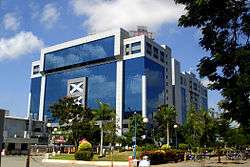
Asia's top eleven important financial centers are located in Singapore, Hong Kong, Shanghai, Tokyo, Dubai, Taipei, Seoul, Mumbai, Doha, Manila and Kuala Lumpur.[106] India has been one of the greatest beneficiaries of the economic boom. The country has emerged as one of the world's largest exporters of software and other information technology related services.[107] World class Indian software giants such as Infosys, Hindustan Computers Limited, Wipro, Mahindra Satyam and Tata Consultancy Services have emerged as the world's most sought after service providers.[108][109]
Call centers are also becoming major employers in Philippines due to the availability of many English speakers, and being a former American colony familiar with the American culture.[110] The rise of the Business Process Outsourcing (BPO) industry has seen the rise of India and China as the other financial centers. Experts believe that the current center of financial activity is moving toward "Chindia" - a name used for jointly referring to China and India - with Shanghai and Mumbai becoming major financial hubs in their own right.
Other growing technological and financial hubs include Dhaka (Bangladesh), Chittagong (Bangladesh), Chennai (India), New Delhi (India), Pune (India), Bangalore (India), Hyderabad (India), Shenzhen (China), Kolkata (India), Jakarta (Indonesia), Kuala Lumpur (Malaysia), Lahore (Pakistan), Metro Manila (Philippines), Cebu (Philippines) and Bangkok (Thailand).
See also
- Overview
- Asia
- History of Asia
- Geography of Asia
- Commonwealth of Independent States
- World economy
- Economy of India
- 1997 Asian financial crisis
- Economy of East Asia
- GDP
- List of Asian and Pacific countries by GDP (nominal)
- List of Asian and Pacific countries by GDP (PPP)
- List of Asian and Pacific countries by GDP (PPP) per capita
References
- ↑ IMF WEO Oct. 2010 Retrieved on October 15, 2010
- ↑ "Asian Millionaires Outnumber Those in North America, Report Says". Bloomberg. 19 June 2012.
- ↑ "Population of Asia in 2014". World Population Statistics. Retrieved 25 November 2014.
- ↑ http://www.adb.org/sites/default/files/publication/177205/asian-economic-integration-report-2015.pdf
- ↑ http://www.e-ir.info/2014/10/16/the-asian-tigers-from-independence-to-industrialisation/
- ↑ http://www.adb.org/sites/default/files/publication/154508/ado-2015.pdf
- ↑ http://nationalgeographic.org/encyclopedia/asia-resources/
- ↑ "Professor M.D. Nalapat. Ensuring China's "Peaceful Rise". Accessed January 30, 2008.".
- ↑ "Dahlman, Carl J; Aubert, Jean-Eric. China and the Knowledge Economy: Seizing the 21st Century. WBI Development Studies. World Bank Publications. Accessed January 30, 2008.".
- ↑ "The Real Great Leap Forward. The Economist. Sept 30, 2004". The Economist.
- ↑ "Chris Patten. Financial Times. Comment & Analysis: Why Europe is getting China so wrong. Accessed January 30, 2008.".
- ↑ http://www.indianscience.org/essays/22-%20E--Gems%20&%20Minerals%20F.pdf
- ↑ "Colonial Rule". National Humanities Center.
- ↑ "Meiji Restoration". Encyclopædia Britannica. Retrieved 25 November 2014.
- ↑ "Sino-Japanese War". Encyclopædia Britannica. Retrieved 25 November 2014.
- ↑ "Manila galleon". Encyclopedia Britannica. Retrieved 25 November 2014.
- ↑ "History of Philippines". Nations Online. Retrieved 25 November 2014.
- ↑ "East India Company". Encyclopedia Britannica. Retrieved 25 November 2014.
- ↑ "Dutch East India Trading Company". Encyclopedia Britannica. Retrieved 25 November 2014.
- ↑ Alfred, Randy. "May 26, 1908: Mideast Oil Discovered — There Will Be Blood". Wired. Retrieved 25 November 2014.
- ↑ "World War 2 in the Pacific". Holocaust Encyclopedia. Retrieved 25 November 2014.
- ↑ "Getting Globalization Right: The East Asian Tigers". OECD Insights.
- ↑ "The East Asian Miracle" (PDF). National Bureau of Economic Research.
- ↑ Allen, G.C. "Japan's Economy recovery". the Journal of Economic History.
- ↑ "Seoul's Green Revolution". time.
- ↑ "Hong Kong's status as world's freest economy threatened by Singapore, says Heritage Foundation". South China Morning Post-Economy.
- ↑ "The Bamboo Network: Asia's Family-run Conglomerates". Strategy +Business.
- ↑ Murray L Weidenbaum (1 January 1996). The Bamboo Network: How Expatriate Chinese Entrepreneurs are Creating a New Economic Superpower in Asia. Martin Kessler Books, Free Press. pp. 4–8. ISBN 978-0-684-82289-1.
- ↑ "Korean War and Japan's Recovery". Office of the Historian.
- ↑ Diener, Betty; Frank, William (March 2010). "The China-India Challenge: A Comparison Of Causes And Effects Of Global Warming". International Business & Economics Research Journal. 9 (3): 21–26. Retrieved 16 November 2014.
- ↑ "Asianomics: Dynamics of Asia's Economic Growth". World Knowledge Forum. Retrieved 16 November 2014.
- ↑ Kogan Page (2003). Asia and Pacific Review 2003/04. Kogan Page Publishers. p. 295. ISBN 978-0-7494-4063-3.
- ↑ Burghardt, Raymond (November 2006). "Old Enemies Become Friends: U.S. and Vietnam". Brookings East Asia Commentary (3). Retrieved 16 November 2014.
- ↑ Morrison, Wayne. "China-U.S. Trade Issues" (PDF). Federation of American Scientist. Retrieved 16 November 2014.
- ↑ Elangkovan, Kaviyarasu; Said, Muhammad (2013). "he Asian Financial Crisis 1997-1998 and Malaysian Response: An Analytical Approach". Australian Journal of Basic and Applied Sciences: 622–633. Retrieved 16 November 2014.
- ↑ "9/11 Attacks". history.
- ↑ Jayasuriya, Sisira; McCawley, Peter. "Reconstruction after a Major Disaster: Lessons from the Post-Tsunami Experience in Indonesia, Sri Lanka, and Thailand" (PDF). ADB Institute. Retrieved 16 November 2014.
- ↑ "Korean War and Japan's Recovery". Office of Historian.
- ↑ Holt, Jeff. "A Summary of the Primary Causes of the Housing Bubble and the Resulting Credit Crisis: A Non-Technical Paper" (PDF).
- ↑ "The Arab Spring of 2005". Seattle Times.
- ↑ "China's Dodgy Data Is Under Scrutiny Again, With Latest GDP Release". Bloomberg Business Week.
- ↑ China: China (Shanghai) Pilot Free Trade Zone (II): New Developments
- ↑ "Shanghai free-trade zone launched". BBC News.
- ↑ Sharma, Manohar; Inchauste, Gabriela; Feng, Juan. "Rising Inequality with High Growth and Falling Poverty and pacific" (PDF). An Eye on East Asia and Pacific (9). Retrieved 16 October 2014.
- ↑ "Military expenditure". SIPRI.
- ↑ "Iraq war illegal, says Annan". BBC News.
- ↑ "Currency Composition of Official Foreign Exchange Reserves (COFER)". International Monetary Fund.
- ↑ World Bank China Office Research Working Paper No. 9 - China Through 2020: A Macroeconomic Scenario
- ↑ "Asia has the world's most billionaires: Survey". Retrieved March 11, 2013.
- ↑ "International Monetary Fund, World Economic Outlook Database, April 2014: Nominal GDP list of countries.".
- 1 2 "China's economic reforms: What you need to know". CNBC. Retrieved 1 October 2014.
- ↑ "Shanghai-Hong Kong Stock Connect" (PDF). Hong Kong Exchanges and Clearing Limited. Retrieved 24 November 2014.
- ↑ Hunter, Gregor (10 November 2014). "China to Start Stock Trading Link Next Week". Wall Street Journal. Retrieved 24 November 2014.
- ↑ "Qualified Foreign Institutional Investor". wikipedia.org.
- ↑ "Shanghai-Hong Kong Stock Connect" (PDF). Hong Kong Exchange and Clearing Limited. Retrieved 24 November 2014.
- ↑ Zhang, Yuanyan; Barnett, Steven (January 2014). "Fiscal Vulnerabilities and Risks from Local Government Finance in China" (PDF). IMF Working Paper: 1–28. Retrieved 24 November 2014.
- ↑ Wildau, Gabriel (2 October 2014). "China to cap local government debt". Financial Times. Retrieved 24 November 2014.
- ↑ "India". International Monetary Fund. Retrieved 2014-04-08.
- ↑ DNA,Indian economy overtaken china growth rate
- ↑ CIA
- ↑ The diplomat
- ↑ The Linkedin
- ↑ Times of India
- ↑ IMF,2015 Survey
- ↑ Foreign Policy
- ↑ The Hindu,India's Service Sector
- ↑ Share of different sectors in Indian GDP Chapter 10, Government of India (February 2014)
- ↑ Indian IT exports,Livemint, 2015
- ↑ Service Exports,2014,Money Control
- ↑ Business Standard,India 4th largest start up hub
- ↑ Agriculture's share in GDP declines to 13.7% in 2012-13 The Economic Times ppppppp
- ↑ Share of different sectors in indian gdp
- ↑ IBEF,Auto Industry.
- ↑ Retail Market,IBEF
- ↑ Business Standard
- ↑ BSE
- ↑ ZeeNews
- ↑ Wall Street Journal
- ↑ "Defining Abenomics". Financial Times. Retrieved 1 October 2014.
- ↑ Xu, Beina. "Abenomics and the Japanese Economy". Council on Foreign Relations. Retrieved 16 November 2014.
- ↑ "Abenomics and the Japanese Economy". Council on Foreign Relations. Retrieved 1 October 2014.
- ↑ "Asia-Pacific Trade Agreement". United Nations: ESCAP. Retrieved 24 November 2014.
- ↑ "About APEC". Asia-Pacific Economic Cooperation. Retrieved 24 November 2014.
- ↑ http://www.apec.org/about-us/about-apec/fact-sheets/regional-economic-integration-agenda.aspx
- ↑ "Overview". ASEAN. org.
- ↑ "ASEAN Member States". ASEAN.org.
- ↑ "East Asia Summit (EAS)". ASEAN.
- ↑ "About ASEAN". Association of Southeast Asian Nations. Retrieved 24 November 2014.
- ↑ "Mainland and Hong Kong Closer Economic Partnership Arrangement (CEPA)". Trade and Industry Department. Retrieved 25 November 2014.
- ↑ "Presentation of the Arab League". Arab League Online.
- ↑ "ABOUT COMMONWEALTH OF INDEPENDENT STATES". INTERSTATE STATISTICAL COMMITTEE OF THE COMMONWEALTH OF INDEPENDENT STATES.
- ↑ "South Asian Association for Regional Cooperation". South Asian Association for Regional Cooperation.
- ↑ "AGREEMENT ON SOUTH ASIAN FREE TRADE AREA (SAFTA)" (PDF). Asia Regional Integration Center.
- ↑ "XE Currency Exchange". XE. Retrieved 16 November 2014.
- ↑ "Mining in Russia and CIS". CountryMine. Retrieved 25 November 2014.
- ↑ Kuepper, Justin (15 March 2013). "A Deeper Look At Russia's Commodity Industry". Commodity HQ. Retrieved 25 November 2014.
- ↑ Gallagher, Kevin; Porzecanski, Roberto (February 2009). "China and the Latin America Commodities Boom: A Critical Assessment" (PDF). Political Economy Research Institute (129): 1–27. Retrieved 25 November 2014.
- ↑ U.S. Energy Information Administration http://www.eia.gov/countries/index.cfm?view=reserves. Retrieved 25 November 2014. Missing or empty
|title=(help) - ↑ "Terrace Cultivation". Encyclopedia Britannica. Retrieved 24 November 2014.
- ↑ "Asia: Agriculture". Encyclopedia Britannica. Retrieved 24 November 2014.
- ↑ "Drug Trafficking". United Nations Office on Drugs and Crime. Retrieved 24 November 2014.
- ↑ "Asia: Resources Environment and Economy". National Geographic. Retrieved 24 November 2014.
- 1 2 Pattanaik, Bandana; Dewar, Fleur; Ham, Julie; Bake-Paterson, Zoë (December 2009). "ASIA: The Changing Context of Trafficking and Migration" (PDF). Alliance News (32): 6. Retrieved 25 November 2014.
- ↑ Brown, Kevin. "Asian Companies Need a Brand New Start". Financial Times. Retrieved 25 November 2014.
- ↑ "Asia". wikipedia.org.
- ↑ Yeandel, Mark; Danev, Nick. "TheGlobal FinancialCentres Index15" (PDF). Long Finance. Retrieved 27 November 2014.
- ↑ Stough, Roger; Thatchenkery, Tojo. "India's Transformation: ICT and Economic Development". Global Studies Review. Retrieved 28 November 2014.
- ↑ "Top 10 software companies in India". Rediff News. Retrieved 28 November 2014.
- ↑ Kapur, Lalit. "What Makes India The Most Sought-After Destination For Offshore Software Development Services?". MAG Studios Blog. Retrieved 28 November 2014.
- ↑ Winn, Patrick (4 May 2014). "How the Philippines is crushing the Indian call center business". Global Post. Retrieved 28 November 2014.
.jpg)
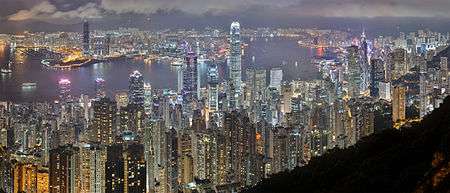
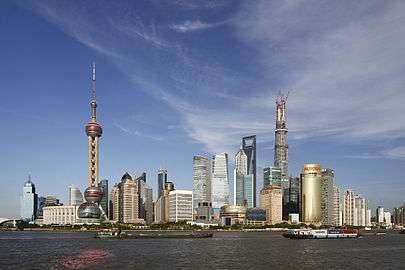


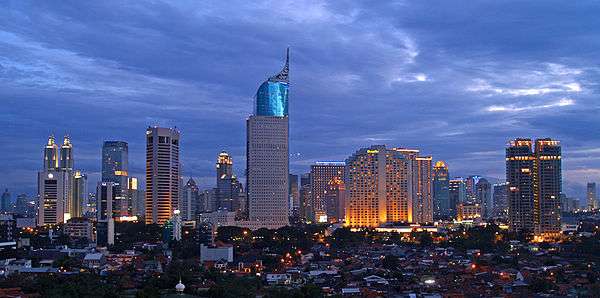
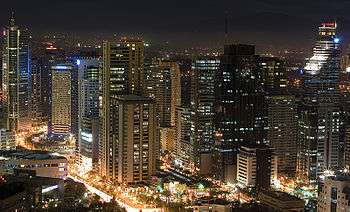

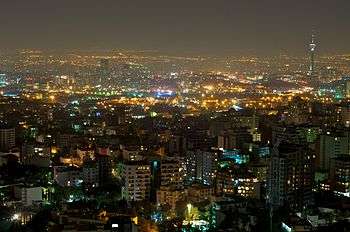
.jpg)
_-_2.jpg)
